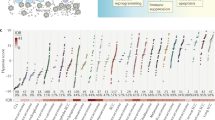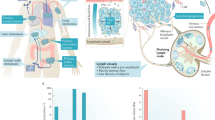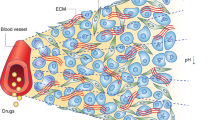Key Points
-
Transcapillary flow, which is important for tissue homeostasis, is influenced by the hydrostatic and colloid osmotic pressures of capillaries and interstitium.
-
The interstitial fluid pressure (IFP) of normal tissues is actively regulated through interactions between stromal cells and the extracellular-matrix molecules.
-
Most solid tumours have increased IFP.
-
The reasons for increased tumour IFP include blood-vessel leakiness, lymph-vessel abnormalities, interstitial fibrosis and a contraction of the interstitial matrix mediated by stromal fibroblasts.
-
Increased tumour IFP causes inefficient uptake of therapeutic agents.
-
Lowering of tumour IFP — for example, by certain cytokine antagonists — can improve drug uptake and thereby improve treatment efficiency.
Abstract
Many solid tumours show an increased interstitial fluid pressure (IFP), which forms a barrier to transcapillary transport. This barrier is an obstacle in tumour treatment, as it results in inefficient uptake of therapeutic agents. There are a number of factors that contribute to increased IFP in the tumour, such as vessel abnormalities, fibrosis and contraction of the interstitial matrix. Lowering the tumour IFP with specific signal-transduction antagonists might be a useful approach to improving anticancer drug efficacy.
This is a preview of subscription content, access via your institution
Access options
Subscribe to this journal
Receive 12 print issues and online access
$209.00 per year
only $17.42 per issue
Buy this article
- Purchase on Springer Link
- Instant access to full article PDF
Prices may be subject to local taxes which are calculated during checkout


Similar content being viewed by others
References
Young, J. S. et al. The significance of the tissue pressure of normal testicular and of neoplastic (Brown–Pearce carcinoma) tissue in the rabbit. J. Pathol. Bacteriol. 62, 313–333 (1950).
Jain, R. K. Transport of molecules across tumor vasculature. Cancer Metastasis Rev. 6, 559–593 (1987).
Jain, R. K. Transport of molecules in the tumor interstitium: a review. Cancer Res. 47, 3039–3051 (1987). References 2 and 3 were the first to propose that the increased IFP of some tumours is a barrier to drug delivery.
Less, J. R. et al. Interstitial hypertension in human breast and colorectal tumors. Cancer Res. 52, 6371–6374 (1992).
Nathanson, S. D. et al. Interstitial fluid pressure in breast cancer, benign breast conditions, and breast parenchyma. Ann. Surg. Oncol. 1, 333–338 (1994).
Curti, B. D. et al. Interstitial pressure of subcutaneous nodules in melanoma and lymphoma patients: changes during treatment. Cancer Res. 53, 2204–2207 (1993).
Boucher, Y. et al. Interstitial hypertension in superficial metastatic melanomas in humans. Cancer Res. 51, 6691–6694 (1991).
Gutmann, R. et al. Interstitial hypertension in head and neck tumors in patients: correlation with tumor size. Cancer Res. 52, 1993–1995 (1992).
Jain, R. K. The next frontier of molecular medicine: delivery of therapeutics. Nature Med. 4, 655–657 (1998).
Jain, R. K. Barriers to drug delivery in solid tumors. Sci. Am. 271, 58–65 (1994).
Boucher, Y. et al. Interstitial pressure gradients in tissue-isolated and subcutaneous tumors: implications for therapy. Cancer Res. 50, 4478–4484 (1990).
DiResta, G. R. et al. Characterization of neuroblastoma xenograft in rat flank. I. Growth, interstitial fluid pressure, and interstitial fluid velocity distribution profiles. Microvasc. Res. 46, 158–177 (1993).
Rippe, B. et al. Transport of macromolecules across microvascular walls: the two-pore theory. Physiol. Rev. 74, 163–219 (1994).
Roh, H. D. et al. Interstitial hypertension in carcinoma of uterine cervix in patients: possible correlation with tumor oxygenation and radiation response. Cancer Res. 51, 6695–6698 (1991).
Milosevic, M. et al. Interstitial fluid pressure predicts survival in patients with cervix cancer independent of clinical prognostic factors and tumor oxygen measurements. Cancer Res. 61, 6400–6405 (2001).
Aukland, K. et al. Interstitial-lymphatic mechanisms in the control of extracellular fluid volume. Physiol. Rev. 73, 1–78 (1993). A thorough and complete review of the mechanisms that control extracellular fluid flow and interstitial fluid pressure.
Chary, S. R. et al. Direct measurement of interstitial convection and diffusion of albumin in normal and neoplastic tissues by fluorescence photobleaching. Proc. Natl Acad. Sci. USA 86, 5385–5389 (1989).
Lund, T. et al. Acute postburn edema: role of strongly negative interstitial fluid pressure. Am. J. Physiol. 255, H1069–H1074 (1988).
Wiig, H. et al. New and active role of the interstitium in control of interstitial fluid pressure: potential therapeutic consequences. Acta Anaesthesiol. Scand. 47, 111–121 (2003).
Reed, R. K. et al. Control of interstitial fluid pressure: role of β1-integrins. Semin. Nephrol. 21, 222–230 (2001).
Meyer, F. A. Macromolecular basis of globular protein exclusion and of swelling pressure in loose connective tissue (umbilical cord). Biochim. Biophys. Acta 755, 388–399 (1983).
Steinberg, B. M. et al. Establishment and transformation diminish the ability of fibroblasts to contract a native collagen gel. J. Cell Biol. 87, 304–308 (1980).
Clark, R. A. F. et al. Platelet isoforms of platelet-derived growth factor stimulate fibroblasts to contract collagen matrices. J. Clin. Invest. 84, 1036–1040 (1989).
Gullberg, D. et al. β1 Integrin-mediated collagen gel contraction is stimulated by PDGF. Exp. Cell Res. 186, 264–272 (1990).
Montesano, R. et al. Transforming growth factor β stimulates collagen-matrix contraction by fibroblasts: implications for wound healing. Proc. Natl Acad. Sci. USA 85, 4894–4897 (1988).
Grundstrom, G. et al. Integrin αvβ3 mediates platelet-derived growth factor-BB-stimulated collagen gel contraction in cells expressing signaling deficient integrin α2β1. Exp. Cell Res. 291, 463–473 (2003).
Reed, R. K. et al. Blockade of β1-integrins in skin causes edema through lowering of interstitial fluid pressure. Circ. Res. 71, 978–983 (1992).
Rodt, S. Å. et al. A novel physiological function for platelet-derived growth factor-BB in rat dermis. J. Physiol. 495, 193–200 (1996). Demonstration that PDGF-BB controls the IFP of normal tissue.
Heuchel, R. et al. Platelet-derived growth factor β receptor regulates interstitial fluid homeostasis through phosphatidylinositol-3′ kinase signaling. Proc. Natl Acad. Sci. USA 96, 11410–11415 (1999).
Wennström, S. et al. Membrane ruffling and chemotaxis transduced by the PDGFβ-receptor require the binding site for phosphatidylinositol 3′ kinase. Oncogene 9, 651–660 (1994).
Berg, A. et al. Cytochalasin D induces edema formation and lowering of interstitial fluid pressure in rat dermis. Am. J. Physiol. Heart Circ. Physiol. 281, H7–H13 (2001).
Berg, A. et al. Effect of PGE1, PGI2, and PGF2 α analogs on collagen gel compaction in vitro and interstitial pressure in vivo. Am. J. Physiol. 274, H663–H671 (1998).
Jain, R. K. Delivery of molecular and cellular medicine to solid tumors. Adv. Drug Deliv. Rev. 46, 149–168 (2001). An authoritative review of the effect on drug uptake of high IFP in tumours.
Baluk, P. et al. Abnormalities of basement membrane on blood vessels and endothelial sprouts in tumors. Am. J. Pathol. 163, 1801–1815 (2003).
Abramsson, A. et al. Analysis of mural cell recruitment to tumor vessels. Circulation 105, 112–117 (2002).
Morikawa, S. et al. Abnormalities in pericytes on blood vessels and endothelial sprouts in tumors. Am. J. Pathol. 160, 985–1000 (2002).
Griffon-Etienne, G. et al. Taxane-induced apoptosis decompresses blood vessels and lowers interstitial fluid pressure in solid tumors: clinical implications. Cancer Res. 59, 3776–3782 (1999).
Padera, T. P. et al. Pathology: cancer cells compress intratumour vessels. Nature 427, 695 (2004).
Boucher, Y. et al. Lack of general correlation between interstitial fluid pressure and oxygen partial pressure in solid tumors. Microvasc. Res. 50, 175–182 (1995).
Dvorak, H. F. et al. Vascular permeability factor/vascular endothelial growth factor, microvascular hyperpermeability, and angiogenesis. Am. J. Pathol. 146, 1029–1039 (1995).
Stohrer, M. et al. Oncotic pressure in solid tumors is elevated. Cancer Res. 60, 4251–4255 (2000).
Alitalo, K. et al. Molecular mechanisms of lymphangiogenesis in health and disease. Cancer Cell 1, 219–227 (2002).
Padera, T. P. et al. Lymphatic metastasis in the absence of functional intratumor lymphatics. Science 296, 1883–1886 (2002).
Leu, A. J. et al. Absence of functional lymphatics within a murine sarcoma: a molecular and functional evaluation. Cancer Res. 60, 4324–4327 (2000).
Boucher, Y. et al. Microvascular pressure is the principal driving force for interstitial hypertension in solid tumors: implications for vascular collapse. Cancer Res. 52, 5110–5114 (1992).
Gabbiani, G. The myofibroblast in wound healing and fibrocontractive diseases. J. Pathol. 200, 500–503 (2003).
Netti, P. A. et al. Enhancement of fluid filtration across tumor vessels: implication for delivery of macromolecules. Proc. Natl Acad. Sci. USA 96, 3137–3142 (1999).
Lee, C. G. et al. Anti-vascular endothelial growth factor treatment augments tumor radiation response under normoxic or hypoxic conditions. Cancer Res. 60, 5565–5570 (2000).
Tong, R. T. et al. Vascular normalization by vascular endothelial growth factor receptor 2 blockade induces a pressure gradient across the vasculature and improves drug penetration in tumors. Cancer Res. 64, 3731–3736 (2004). Reports that vessel normalization after VEGF-antagonist treatment induces favourable transvascular hydrostatic pressure gradient in tumours.
Wildiers, H. et al. Effect of antivascular endothelial growth factor treatment on the intratumoral uptake of CPT-11. Br. J. Cancer 88, 1979–1986 (2003).
Willett, C. G. et al. Direct evidence that the VEGF-specific antibody bevacizumab has antivascular effects in human rectal cancer. Nature Med. 10, 145–147 (2004). Describes the first analysis of the effect of a VEGF antagonist on tumour vasculature and IFP in patients.
Inai, T. et al. Inhibition of vascular endothelial growth factor (VEGF) signaling in cancer causes loss of endothelial fenestrations, regression of tumor vessels, and appearance of basement membrane ghosts. Am. J. Pathol. 165, 35–52 (2004).
Pietras, K. et al. Inhibition of platelet-derived growth factor receptors reduces interstitial hypertension and increases transcapillary transport in tumors. Cancer Res. 61, 2929–2934 (2001).
Pietras, K. et al. Inhibition of PDGF receptor signaling in tumor stroma enhances antitumor effect of chemotherapy. Cancer Res. 62, 5476–5484 (2002). Demonstrates that PDGF antagonists lower tumour IFP, as well as increase drug uptake and treatment efficiency in preclinical models.
Pietras, K. et al. STI571 enhances the therapeutic index of epothilone B by a tumor-selective increase of drug uptake. Clin. Cancer Res. 9, 3779–3787 (2003).
Pietras, K. Increasing tumor uptake of drugs with imatinib. Semin. Oncol. 31, 18–23 (2004).
Lindahl, P. et al. Pericyte loss and microaneurysm formation in PDGF-B-deficient mice. Science 277, 242–245 (1997).
Abramsson, A. et al. Endothelial and nonendothelial sources of PDGF-B regulate pericyte recruitment and influence vascular pattern formation in tumors. J. Clin. Invest. 112, 1142–11451 (2003).
Guo, P. et al. Platelet-derived growth factor-B enhances glioma angiogenesis by stimulating vascular endothelial growth factor expression in tumor endothelia and by promoting pericyte recruitment. Am. J. Pathol. 162, 1083–1093 (2003).
Furuhashi, M. et al. Platelet-derived growth factor production by B16 melanoma cells leads to increased pericyte abundance in tumors and an associated increase in tumor growth rate. Cancer Res. 64, 2725–2733 (2004).
Lammerts, E. et al. Interference with TGF-β1 and -β3 in tumor stroma lowers tumor interstitial fluid pressure independently of growth in experimental carcinoma. Int. J. Cancer 102, 453–462 (2002).
Jacobson, A. et al. Hyaluronan content in experimental carcinoma is not correlated to interstitial fluid pressure. Biochem. Biophys. Res. Commun. 305, 1017–1023 (2003).
Eikenes, L. et al. Collagenase increases the transcapillary pressure gradient and improves the uptake and distribution of monoclonal antibodies in human osteosarcoma xenografts. Cancer Res. 64, 4768–4773 (2004).
Kristensen, C. A. et al. Reduction of interstitial fluid pressure after TNF-α treatment of three human melanoma xenografts. Br. J. Cancer 74, 533–536 (1996).
Curnis, F. et al. Improving chemotherapeutic drug penetration in tumors by vascular targeting and barrier alteration. J. Clin. Invest. 110, 475–482 (2002).
Brekken, C. et al. Hyaluronidase-induced periodic modulation of the interstitial fluid pressure increases selective antibody uptake in human osteosarcoma xenografts. Anticancer Res. 20, 3513–3519 (2000).
Brekken, C. et al. Interstitial fluid pressure in human osteosarcoma xenografts: significance of implantation site and the response to intratumoral injection of hyaluronidase. Anticancer Res. 20, 3503–3512 (2000).
Brekken, C. et al. Hyaluronidase reduces the interstitial fluid pressure in solid tumours in a non-linear concentration-dependent manner. Cancer Lett. 131, 65–70 (1998).
Kristjansen, P. E. G. et al. Dexamethasone reduces the interstitial fluid pressure in a human colon adenocarcinoma xenograft. Cancer Res. 53, 4764–4766 (1993).
Emerich, D. F. et al. Bradykinin modulation of tumor vasculature: II. activation of nitric oxide and phospholipase A2/prostaglandin signaling pathways synergistically modifies vascular physiology and morphology to enhance delivery of chemotherapeutic agents to tumors. J. Pharmacol. Exp. Ther. 296, 632–641 (2001).
Lee, I. et al. Nicotinamide can lower tumor interstitial fluid pressure: mechanistic and therapeutic implications. Cancer Res. 52, 3237–3240 (1992).
Rubin, K. et al. Lowering of tumoral interstitial fluid pressure by prostaglandin E1 is paralleled by an increased uptake of 51Cr–EDTA. Int. J. Cancer 86, 636–643 (2000).
Salnikov, A. V. et al. Lowering of tumor interstitial fluid pressure specifically augments efficacy of chemotherapy. FASEB J. 17, 1756–1758 (2003). Demonstration that prostaglandin E 1 lowers tumour IFP and increases treatment efficiency in preclinical models.
Thurston, G. et al. Angiopoietin-1 protects the adult vasculature against plasma leakage. Nature Med. 6, 460–463 (2000).
Kristensen, C. A. et al. Reduction of interstitial fluid pressure after TNF-α treatment of three human melanoma xenografts. Br. J. Cancer 74, 533–536 (1996).
Acknowledgements
The authors thank I. Schiller for skilful help in the preparation of this manuscript. Work in the authors laboratories were, in part, supported by funds from the Swedish Cancer Society. The authors also thank editors and anonymous reviewers for valuable suggestions.
Author information
Authors and Affiliations
Corresponding author
Ethics declarations
Competing interests
The authors declare no competing financial interests.
Related links
Related links
DATABASES
Cancer.gov
Entrez Gene
FURTHER INFORMATION
Glossary
- COLLOID OSMOTIC PRESSURE
-
A pressure built up by the tendency of water to diffuse through a semipermeable membrane into a compartment with higher concentration of high-molecular-weight molecules, like proteins, that are unable to pass through the membrane.
- HYDRAULIC CONDUCTIVITY
-
A measure of the permeability of the vessel wall for water.
- PROTEIN REFLEXION COEFFICIENT
-
A measure of the impermeability of the capillary vessel wall for proteins.
- STARLING'S FORCES
-
Starling's hypothesis describes the transcapillary fluid flux, Jv, as Jv = Lp × S × ΔP, where Lp is the hydraulic conductivity of the capillary membrane and S is the surface area for exchange. ΔP is the net pressure difference determined by ΔP = (PCAP − PIF) − σ(COPCAP − COPIF), where PCAP and PIF are the hydrostatic pressures in capillaries and interstitium, respectively; COPCAP and COPIF are the colloid osmotic pressures of capillaries and interstitium, respectively; and σ is the plasmaprotein reflexion coefficient for proteins.
- INTEGRINS
-
Transmembrane receptors, consisting of different combinations of α- and β-subunits. Many bind different extracellular-matrix proteins, such as collagen, fibronectin and laminin.
- HYALURONAN
-
A large linear polysaccharide of repeating disaccharide units. It crosslinks proteoglycans and so contributes to the elasticity of tissues.
- PERICYTES
-
Mural cells present in capillaries and venules that are embedded in the basal lamina and also form close contact with endothelial cells. Pericytes are recruited to blood vessels by PDGF-BB produced by endothelial cells.
- ANGIOTENSIN II
-
A short peptide that, after cleavage from its precursor, binds to a G-protein-coupled receptor present on vascular smooth muscle cells and increases the blood pressure.
- DNA APTAMER
-
A DNA molecule of 20–40 nucleotides, obtained by a repeated selection procedure, which specifically binds other molecules with high affinity.
- HYDROXYPROLINE
-
A post-translationally modified amino acid, hydroxylated proline, often detected in collagen.
- 51Cr-EDTA
-
A low-molecular-weight compound that is widely used as a tracer for extracellular fluid. It is not taken up by cells and distributes freely between blood and interstitial fluids.
- MICRODIALYSIS
-
A method to determine transport of low-molecular-weight compounds from blood to tissues. A small dialysis probe, usually about 0.3 × 5 mm is inserted in the tissue and connected to a pump. The concentration of the low-molecular-weight compound in the dialysate is determined and related to the concentration in blood.
Rights and permissions
About this article
Cite this article
Heldin, CH., Rubin, K., Pietras, K. et al. High interstitial fluid pressure — an obstacle in cancer therapy. Nat Rev Cancer 4, 806–813 (2004). https://doi.org/10.1038/nrc1456
Issue Date:
DOI: https://doi.org/10.1038/nrc1456
This article is cited by
-
The promise and challenges of combination therapies with antibody-drug conjugates in solid tumors
Journal of Hematology & Oncology (2024)
-
Nucleic acid-based drugs for patients with solid tumours
Nature Reviews Clinical Oncology (2024)
-
Immunosurveillance encounters cancer metabolism
EMBO Reports (2024)
-
An in silico model of the capturing of magnetic nanoparticles in tumour spheroids in the presence of flow
Biomedical Microdevices (2024)
-
The impact of tumor microenvironment: unraveling the role of physical cues in breast cancer progression
Cancer and Metastasis Reviews (2024)



